Preferences in the use of social media for seeking and communicating health and lifestyle information
Ágústa Pálsdóttir
Department of Information Science, University of Iceland, Gimli v/Sæmundargötu, 101 Reykjavík, Iceland
Introduction
The paper presents findings from a study investigating the health and lifestyle information behaviour of different groups of Icelanders. The paper focuses on the use of social media and its role in information behaviour today.
The means of seeking, sharing and disseminating information has undergone huge changes in recent years. In particular, social media (e.g. Facebook, Twitter, Wikipedia, YouTube, blog, etc.) has in the past few years radically transformed the way that people can communicate. Information behaviour has been described as an encompassing and multifaceted concept comprising all human interaction with information, namely acknowledgement of a need for information, seeking and evaluating information, as well as the use of it (Wilson, 2000). Social connections are particularly important in this respect because they can create and stimulate the flow of information. Social media offers promising possibilities at both disseminating and gathering information and the information derived from it is becoming increasingly important in people's everyday lives. For example, while many social networks preserve and support communication within pre-existing social relations, other sites are primarily based on shared interests, where either a broad and diverse group of strangers or a more narrow and intimate group of people can connect and discuss with one another (Boyd and Ellison, 2007).
Knowledge of how interest in healthy behaviour can be provoked, how the decision to take up a more healthy behaviour can be enhanced, and how the maintenance of a healthy behaviour change can be supported, is an important aspect of health promotion and has a strong connection to information behaviour (Prochaska and Velicer, 1997). Social media has the potential to support and influence information behaviour in several ways. For example, health specialists can present quality information about healthy living and potentially inspire people to discover such information. Additionally, friends or acquaintances can provide support and inspiration through discussions. The main change from traditional internet sources has been from monologue, where information is disseminated through webpages, newspapers or journals on the Web, to dialogue, where several people can communicate, ask questions, exchange information and get feedback from one another. Although this may create challenges, with the possibility of the spread of inaccurate and misleading information, it also provides health professionals with new opportunities to disseminate information about healthy living, as well as for people to gather such information and receive health support.
The Pew Internet Project has conducted a series of studies to examine trends in the use of Internet sources in America since 2000. Their findings show that even though social media is being used by 46% of all American adults and 62% of adult internet users (Fox, 2011), the use of social media among American older adults has been growing significantly in the past few years (Zickuhr and Madden, 2012). However, the use of social media for communicating about health information is only moderate (Fox, 2011). This is in line with previous findings about online information seeking which indicates that most people seem to seek online health information infrequently (Lorence, Park and Fox, 2006).
Kontos et al. (2010) have examined the demographic profile of adult users of social networking sites for health information and found that the use decreased as age increased and that those with lower education and income levels were more frequent users of social networking sites than those with more education and higher income levels. The use of social networking sites among Icelanders has been examined by Statistics Iceland (2012), which reported that 69% of Icelanders used social networking sites in 2012. Women and younger people were found to be the most active users of social networking sites.
Social networking sites have proved to be influential in improving access to health related information (Freyne et al., 2010, Zhang, He and Sang, 2013). It seems that people may have impact on the health behaviour of others by offering them opinions and advice (Scanfeld, Scanfield and Larson, 2010), as well as using social media to provide emotional support (Moen, Smordal and Sem, 2009, Oha et al., 2013, Savolainen, 2010). It has, however, also been noted that the reliability and usefulness of the information may be questionable (Moorhead, Hazlett, Harrison, et al., 2013; Sajadi and Goldman, 2011) and health professionals have been encouraged to employ social media for the interaction and sharing of quality information about health topics to the public (Robillard et al., 2013).
Health lifestyles have been defined as "collective patterns of health-related behaviour based on choices from options available to people according to their life chances" (Cockerham, 2005: 55). In Iceland it is common to use the phrase health and lifestyle in relation to health promotion, e.g. in the media and by health specialists. Health and lifestyle refers to the lifestyle choices that people make and the impact it can have on their health. Information about physical exercise, healthy diets and how these can affect people's health has frequently been in the public debate in Iceland in recent years.
The present study investigates preferences for employing social media to communicate and seek information about health and lifestyle and compares it to their information seeking activity in other channels. Knowledge of the various factors related to information behaviour and the use of social media is limited. Research in this area, particularly in relation to health information, is scarce internationally and practically non-existent in Iceland. It is therefore interesting to investigate the use of social media in relation to health and lifestyle information behaviour and seek answers to the following research question:
- how do different groups of Icelanders prefer to use social media to seek and communicate information about health and lifestyle?
- What is their use of social media in relation to health and lifestyle information compared with other information channels?
Methods
Previous studies exploring the use of social media for communicating and seeking information have employed both qualitative and quantitative methods with good results. They have, for example, identified various ways in which social media is used to acquire information. The purpose of this study is to compare different groups within society, examining their use of social media and the preferred ways of using it, as well as to compare the use of social media with other information channels. As the study aims to generalize the results to the wider population of Icelanders, it was decided to use quantitative methods in the study.
Data collection
Data were gathered from two samples using an internet and a telephone survey. For the telephone survey, a sample representing the adult population in Iceland was used, consisting of 600 people from the whole country, aged 18 years and older and randomly selected from the National Register of Persons in Iceland. Participants were contacted by telephone and invited to answer the survey directly by telephone or by email.
For the internet survey, a random sample of 600 people from the Social Science Research Institute at the University of Iceland net panel was used. The net panel consists of people aged 18 years or older from the whole country. A random sample from the National Register of Persons in Iceland was contacted by telephone and people were asked if they were willing to participate in the net panel. The choice of participants in the net panel follows strict methodological rules to avoid convenience sampling. The net panel is updated regularly to ensure that it corresponds with the distribution in the population, regarding sex, age and residence.
The data were gathered in spring 2012. Respondents consisted of 299 individuals belonging to the simple random sample drawn from the National Register who were reached by telephone and 399 participants in the net panel. Women were overrepresented in the telephone survey, with 57.2% of the respondents being women. However, of those who participated in the net panel survey, 50.9% were women and 49.1% were men. The age distribution of respondents from both samples was also different although not statistically significant. The respondents who answered the telephone survey (or provided their email addresses over the telephone) were slightly younger than the net panel respondents. While 20.4% of those answering the telephone survey were 18 to 29 years of age, the same held for 16.3% of those who belonged to the net panel. It can therefore be said that each data collection method has advantages and disadvantages. The net panel reaches both men and women but those who belong to the youngest age groups (18-29 and 30-39) were reluctant to answer surveys sent out to the net panel. By combining the datasets from these two surveys, the sex and age distribution was closer to the corresponding distribution in the population. Both datasets were therefore merged, allowing answers from all individuals belonging to each set of data.
The total response rate was 58.4%. Table 1 presents a comparison of the characteristics of the respondents in the combined dataset, as well as in each dataset, with population parameters derived from Statistics Iceland.
| CATI/CAWI sample | Net Panel sample | Combined sample | Population | |
|---|---|---|---|---|
| % raw number) | %(raw number) | %(raw number) | %(raw number) | |
| Sex | ||||
| Men | 42.8 (128) | 49.1 (196) | 46.4 (324) | 49.9 (119.519) |
| Women | 57.2 (171) | 50.9 (203) | 53.6 (374) | 50.1 (120.205) |
| Total | 100% (299) | 100% (399) | 100% (698) | 100% (239.724) |
| Age | ||||
| 18-29 | 20.4 (61) | 16.3 (65) | 18.1 (126) | 24.2 (56.111) |
| 30-39 | 19.4 (58) | 16.5 (66) | 17.8 (124) | 19.8 (44.364) |
| 40-49 | 16.7 (50) | 19.5 (78) | 18.3 (128) | 20.3 (42.263) |
| 50-59 | 16.4 (49) | 19.8 (79) | 18.3 (128) | 17.0 (40.424) |
| 60+ | 27.1 (81) | 27.8 (111) | 27.5 (192) | 18.7 (56.562) |
| Total | 100% (299) | 100% (399) | 100% (698) | 100% (239.724) |
| Education | ||||
| Primary | 23.5 (70) | 16.5 (66) | 19.5 (136) | 28.7 (68,801) |
| Secondary | 43.0 (129) | 43.0 (172) | 42.9 (301) | 40.1 (96.129) |
| University | 33.5 (100) | 40.5 (161) | 37.6 (261) | 31.2 (74,794) |
| Total | 100% (299) | 100% (399) | 100% (698) | 100% (239.724) |
For the combined dataset, the distribution of men and women reflects the population. The distribution of age, for the combined dataset, falls within the 95% confidence limits for three out of five age groups, however there are more people in the oldest age group and less people in the youngest age group compared to the population. Educational level was measured as the highest level of education completed. Three levels were distinguished: primary education includes those who have finished compulsory education (ten years of education); secondary education includes those who have completed vocational training, or secondary school; and university education. The proportion of people with secondary education in the combined dataset is representative of the population. However, as a proportion of the population, more people with university education and fewer with primary education responded to the questionnaire.
Measurements
(1) Socio-demographic information included the variables: sex, age, marital status, residence, education and income.
(2) Purposive information seeking. A list of 25 information sources was presented and respondents were asked: 'Have you sought information about health and lifestyle in any of the following sources'? A five-point response scale was used (Very often - Never). The information sources were grouped into four information channels named media, health specialists, Internet and interpersonal sources and total mean scores computed for each channel. The information channels were tested for internal reliability and in all cases, Cronbach's alpha proved satisfactory. For media it was 0.95; for health specialists it was 0.90; for Internet it was 0.94; and for interpersonal sources it was 0.85.
(3) Social media use. The participants were asked if they had used social media (e.g. Facebook, Wikipedia, Twitter, YouTube, blog, etc.) and asked seven questions about the various ways in which they had used social media in relation to health and lifestyle information. This included questions about whether the participants had provided information about health and lifestyle to social media, whether they had received information from others, commented, forwarded or "liked" information in social media. A five-point response scale was used (Very often - Never).
In addition to measuring the use of social media, it was decided to use the Principal Component Factoring method of extraction to examine the factor structure of the questions asked. The criteria for factor loadings were set above 0.3 and oblique rotation (Oblimin) was adopted in the analyses. For the analyses, multiple criteria, based on eigenvalue > 1.00 and a scree test suggested that extracting one factor would be adequate. The factor which was named Social media explained 74.39% of the total variance in the data. The scale was checked for internal reliability and Cronbach's alpha was 0.93.
Analysis of the data
Owing to different response rates in two of the age groups and educational groups, the data were weighted to ensure that each group had the correct proportionate weight in the overall results for the sample in comparison to the population as a whole. All results are shown weighted.
The relationship between background variables and each question about the use of social media was analysed using chi-squared.
As the objective is to provide a picture which is different from traditional analysis of the data with socio-demographic variables, a k-means cluster analysis was used to determine how the participants formed distinct groups based on their purposive information seeking (Everitt, Landau and Leese, 2001). Only those who gave answers with 20 sources or more were included (N=674). Building on analysis of data from previous research, a four-cluster solution was drawn (Aldenderfer and Blashfield, 1984; Everitt et al., 2001; Pálsdóttir, 2005; Pálsdóttir, 2009).
The relationship between each of the seven questions about the use of social media and the information-seeking clusters was analysed by analysis of variance. A post-hoc test (Tukey) was conducted to examine which of the four clusters differ significantly.
The variable social media was skewed. It was transformed into a dichotomous variable: participants who had used social media, and participants who had never used social media, in relation to health and lifestyle information. Binary logistic regression, controlling for background variables, was used to analyse the use of the cluster of social media. The spasmodic cluster was used as a comparable group against which the other clusters were measured. In the analysis, participants who had used social media were given the value 1, and those who had never used social media were given the value 0. Consequently, the results indicate that for values over 1 on Exp (B), the odds of using social media increase as the value of the independent variable gets higher. Values under 0 indicate that the odds of using social media decrease as the value of the independent variable gets lower.
Results
The participants were asked a number of questions about the use of social media in relation to information about health and lifestyle. This chapter will start by introducing results about how the background variables, sex, age and education, relate to each question. This will be followed by presenting the results from the cluster analysis and after that the results about the information-seeking cluster's use of social media will be introduced. The results from the analyses of the variable social media and how it relates to the background variables is then presented and finally the results from the analysis of social media and the information-seeking clusters.
Use of social media and relationship with background variables: sex, age and education
The relationship between each question about the use of social media and the background variables was analysed by using chi-squared. Only results about significant differences will be presented in Figures 1 to 7.
The participants were asked if they had posted information about health and lifestyle in social media, for example by sharing a link, referring to an article or by posting their own text. The results are presented in Figure 1.
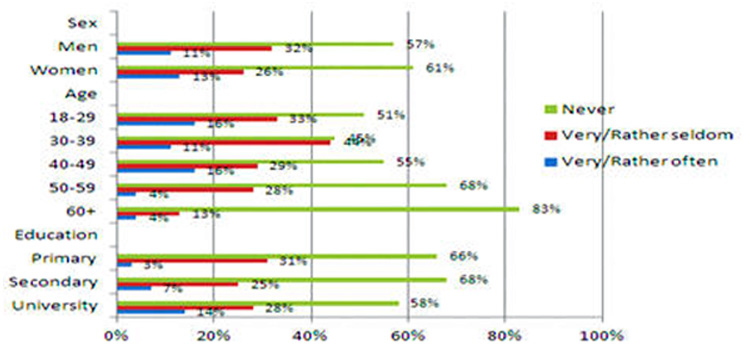
Figure 1 shows that women were more likely to have posted information about health and lifestyle than men (p<.01). The results also show a difference by age, with those in younger age groups being more likely to have posted information than those in the older age groups (p<.001). Additionally, participants with more education were more likely to have posted information than those with less education (p<.05).
Figure 2 presents results about participant's responses to health and lifestyle information which others had posted into social media.
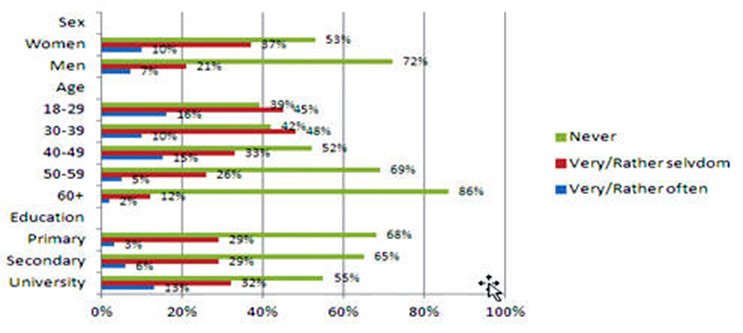
As is clear from Figure 2, there was a significant difference by sex, age and education. Women were more likely than men to have commented on information that others had posted (p<.001) and younger participants were more likely to have made comments than those who were older (p<.001). Participants with more education were also more likely to have commented on information than those who had less education (p<.05).
Results about how often participants had received information about health and lifestyle through social media, are presented in Figure 3.
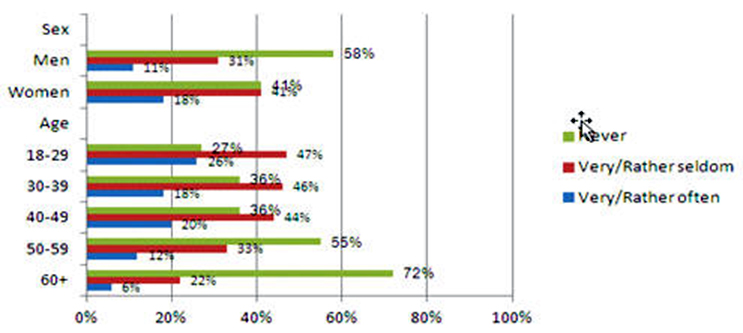
Figure 3 shows significant differences by sex and education. Women were more likely to have received information about health and lifestyle from others than men (p<.001) and those who are younger were more likely to have received information than those who are older (p<.001).
Participants were asked if they had forwarded or "liked" information about health and lifestyle that others had posted on social media. The results are shown in Figure 4.
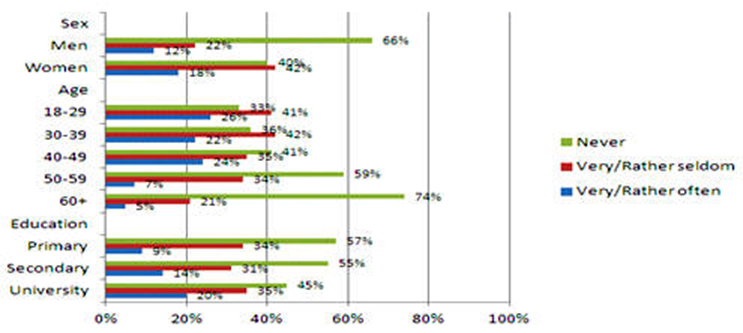
Figure 4 shows that women were more likely to have forwarded or "liked" information that others had posted in social media than men (p<.001) and that those who are younger were more likely to have done so than those who are older (p<.001). In addition, those who are more educated were more likely to have forwarded or "liked" information than those who have less education (p<.05).
Figure 5 presents results about if the participants had read an article about health and lifestyle by opening a link in social media.
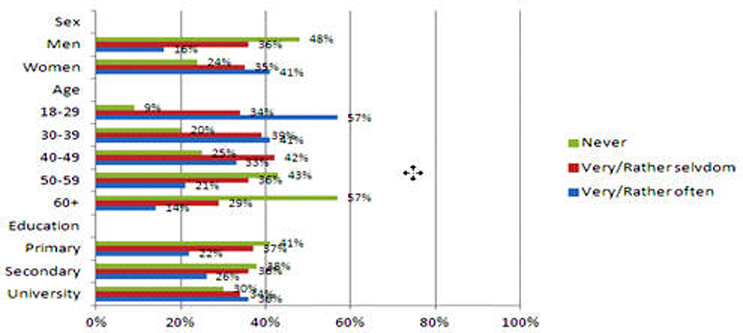
Figure 5: Read articles about health and lifestyle through social media - difference by sex, age and education
As can be seen in Figure 5, there was as significant difference by participants' sex, age and education. Women were more likely to have read an article about health and lifestyle in social media than men (p<.001). Results about age show that younger people were more likely to have done so than those who are older (p<.001). More educated participants were more likely to have read an article in social media (p<.05).
The participants were also asked if they had opened a link and read an advertisement about health and lifestyle in social media, see Figure 6.
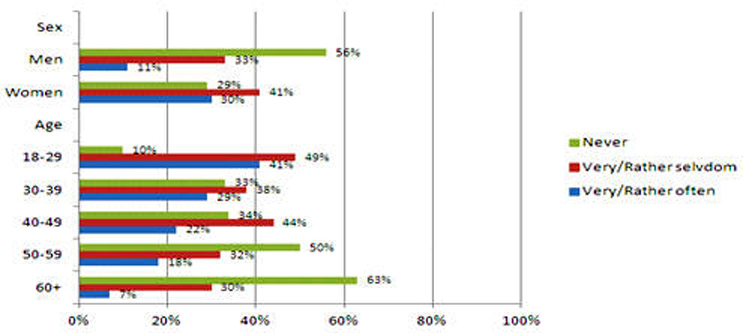
Figure 6: Read advertisements about health and lifestyle through social media - difference by sex, age and marital status
Figure 6 shows that women were more likely to have read advertisements about health and lifestyle on social media than men (p<.001) and that younger people were more likely to have done so than those who were older (p<.001).
Finally, results about how often the participants had signed up as friends or "liked" Facebook sites about health and lifestyle are presented in Figure 7.
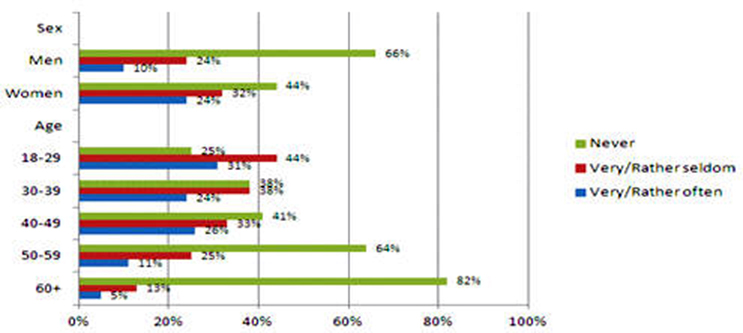
Figure 7: Signed up as friends or "liked" Facebook sites about health and lifestyle - difference by sex and age
Figure 7 shows that a significant difference was found for sex (p<.001), with women being more likely than men to have signed as friends or "liked" a health and lifestyle Facebook site. For age (p<.001), younger participants were more likely to have signed as friends or "liked" information on Facebook than older participants.
Background variables and different ways of using social media: Most likely and least likely actions
Combining the answers "very/rather often" and "rather seldom/very seldom", the results in Figures 1-7 show that men and women share an interest in seeking knowledge about health and lifestyle on social media by reading articles (men: 52%, women: 76%). Men were, on the other hand, least likely to comment on information that others had posted (28%), while women were least likely to post information to social media (39%).
The results for the variables age and education are identical to the results about sex. For all the age groups, reading articles (18-29: 91%, 30-39: 80%, 40-49: 75%, 50-59: 57%, 60+: 43%) was the most likely action, followed by advertisements (18-29: 90%, 30-39: 67%, 40-49: 66%, 50-59: 50%, 60+: 37%). Posting information about health and lifestyle to social media was the least likely action (18-29: 49%, 30-39: 55%, 40-49: 45%, 50-59: 32%, 60+: 17%).
Results for the variable, education show that reading articles was also the most likely action (primary: 59%, secondary: 62%, university: 70%) followed by posting information (primary: 34%, secondary: 32%, university: 42%). Commenting on information posted by others (primary: 32%, secondary: 35%, university: 45%) was the least likely action.
Information-seeking clusters
Four clusters were drawn based on the participant's purposive information seeking. Information seeking activity of the cluster's was assessed by computing total mean scores for each of the information channels: media, health specialists, Internet and interpersonal sources. Post hoc tests (Tukey's tests) were carried out to examine statistical differences across the clusters. Figure 8 presents an overview of the total mean scores (1 is never and 5 very often).
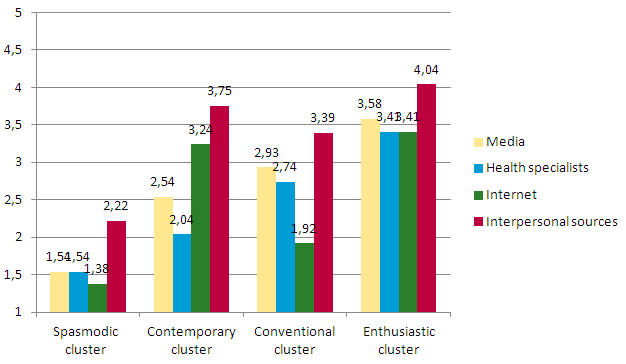
Figure 8: Purposive information seeking activity across the information-seeking clusters
The clusters were named with reference to their information seeking activity and to their choice of information channels: spasmodic cluster (N=219; 218), conventional cluster (N=156; 176), contemporary cluster (N=59; 63) and the enthusiastic cluster (N=211; 217). The numbers for each cluster are first shown as weighted; and after that, as the actual number of respondents.
Figure 8 shows that all the clusters prefer to seek information from interpersonal sources, by talking to members of their family, close friends or acquaintances.
The spasmodic cluster seeks information least often. The information seeking activity of this cluster, which is generally low, is similar for media, health specialists and Internet but higher for Interpersonal sources.
Information seeking in all channels was high in the enthusiastic cluster. The total mean scores for the information channels, besides interpersonal sources, suggest that members of this cluster are the most enthusiastic seekers of information with a preference for a broad spectrum of information sources.
The difference in information seeking activity across the contemporary and the conventional clusters is small; the main difference between these two clusters lies in their preferences for information channels. Members of the contemporary cluster seek information more often from the internet and interpersonal sources while members of the conventional cluster seeks information more often in media and from health specialists (Tukey, p<0.05).
Information-seeking clusters and use of social media
Analysis of variance was used to examine the relationship between each of the seven questions about the use of social media and the information-seeking clusters. The results are presented in mean figures in Figure 9.
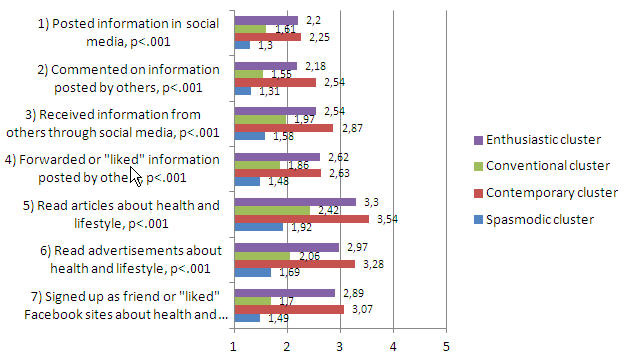
Figure 9: Use of social media by the information-seeking clusters
Figure 9 shows a significant difference across the clusters for all questions regarding the use of social media. For the first and the last questions (marked as 1 and 7), the same kind of difference was found across the clusters. Members of the contemporary and the enthusiastic clusters, which did not differ significantly, had posted information in social media (p<.001), and signed up as friends or "liked" Facebook sites about health and lifestyle (p<.001), significantly more often than members of the spasmodic and conventional clusters.
For the second question (2) it was found that members of the contemporary cluster had commented on information about health and lifestyle from others most often, while members of the spasmodic and conventional clusters, which did not differ significantly, had done so least often. (p<.001).
For the other four questions (marked as 3, 4, 5 and 6) the same pattern of difference was found across the clusters in all cases (p<.001). Members of the spasmodic cluster had received information about health and lifestyle (3) (p<.001), forwarded or "liked" information posted by others (4) (p<.001), and read both articles (5) (p<.001) and advertisements (6) (p<.001) about health and lifestyle through social media, the least often. Members of the conventional cluster had participated in these activities less often than members of the enthusiastic and contemporary clusters, which did not differ significantly.
All four clusters preferred to use social media to open links to read articles about health and lifestyle and to read advertisements. After that members of the spasmodic and conventional clusters preferred to receive information from others and to forward or like information from others. Members of the enthusiastic and contemporary clusters, on the other hand, preferred to sign up as friends or like Facebook sites about health and lifestyle.
Functions that are of a more social nature, such as communicating with others by posting information about health and lifestyle, or making comments to information which others have posted, were least frequent by all the clusters.
Analysis of the scale social media
In the final step of the examination, the seven questions about the use of social media were analysed by use of factor analysis. One factor was extracted and given the name social media. The variable was skewed and was therefore transformed into a dichotomous variable: participants who have used social media, and participants who have never used social media, in relation to health and lifestyle information.
Relationship between the scale social media and background variables
The results from chi-squared analysis of the relationship between the variable social media and the background variables are presented in table 2.
| Have used social media | Never used social media | |
|---|---|---|
| Sex*** | ||
| Men | 59% | 41% |
| Women | 82% | 18% |
| Age*** | ||
| 18-29 | 97% | 3% |
| 30-39 | 85% | 15% |
| 40-49 | 80% | 20% |
| 50-59 | 66% | 34% |
| 60+ | 48% | 52% |
| Education* | ||
| Primary | 63% | 37% |
| Secondary | 70% | 30% |
| University | 77% | 23% |
| Significant difference between groups; *p<.05, **p<.01, ***p<.001 | ||
Table 2 shows that there is a significant difference by sex. Women are more likely to have used social media in relation to information about health and lifestyle. The use of social media also differed by age. The results show that the younger the participants are, the more likely they are to have used social media. Educational difference shows that more educated participants were more likely to have used social media.
A binary logistic regression model was used to examine the effects of each of the background variables that showed significant results in table 2 on the use of Social media, by controlling for the other background variables. The results are presented in table 3.
| B | Standard deviation | Exp(B) | |
|---|---|---|---|
| Sex (1=women) | 1.132*** | .227 | 3.101 |
| Age | -.062*** | .007 | .940 |
| Secondary education | -.543 | .297 | .581 |
| University education | -.112 | .249 | .894 |
| Constant | 3.858 | .491 | 47.393 |
| Significant difference between groups; *p<.05, **p<.01, ***p<.001 | |||
As can be seen from table 3, when other background variables are being controlled for, there is still a significant difference by sex and by age. The results show that women are more likely to have used social media than men and that with growing age, the participants are less likely to have used social media. There wasn't, however, any significant difference by education.
Relationship between the scale social media and the information-seeking clusters
Table 4 shows results of the scale social media. Binary logistic regression, controlling for background variables, was used in the analysis and the spasmodic cluster used as a comparable group which the other clusters were measured against.
| B | Standard deviation | Exp(B) | |
|---|---|---|---|
| Sex2 | 988*** | .257 | 2.686 |
| Age | -.059*** | .008 | .943 |
| Contemporary | 3.047*** | 1.036 | 21.046 |
| Enthusiastic | 1.314*** | .340 | 3.721 |
| Secondary | .252 | .282 | 1.286 |
| University | .445 | .317 | 1.561 |
| Constant | 2.973 | .501 | 19.559 |
| Significant difference between groups; *p<.05, **p<.01, ***p<.001 | |||
Table 4 shows that there is a significant difference across the spasmodic cluster and each of the other three clusters. The odds of using social media are higher for the contemporary, conventional and enthusiastic clusters than for the spasmodic cluster. In addition, the variables sex and age are significant.
Discussion
The primary purpose of the present study is to develop an understanding of the health and lifestyle information behaviour of Icelanders, with special emphasis on social media and its role in information behaviour today. By doing so the study contributes to the small but growing body of evidence about the use of social media as a communication method. Although social media offers new and innovative possibilities for health education, knowledge of it is scarce and the study addresses a gap in the existing literature both internationally and in Iceland.
The study approached the matter by asking several questions about various ways in which people seek, receive or disseminate information through social media. The results of the study show a difference in activity by groups within society. This is not an unexpected finding in itself. However, the results also show that, no matter what group the participants belonged to, they all preferred to use social media to get information by reading articles about health and lifestyle. This is an interesting finding in light of concerns that have been expressed about the likelihood of dubious information being disseminated through social media (Moorhead, Hazlett, Harrison, et al., 2013; Sajadi and Goldman, 2011)). Contrary to these worries, the results from the study, which are identical for all groups, show that functions that are of a more social nature, such as communicating with others by posting information about health and lifestyle, or making comments about information which others have posted, were least frequent.
The, present study, therefore, suggests that social media provides health professionals with a good opportunity to reach certain groups within society and disseminate quality information to them.
The study, furthermore, identified the socio-demographic characteristics of the participants and how these relate to the different ways of using social media for health and lifestyle information. In addition, cluster analysis was used to group participants into four distinct clusters, based on their purposive information seeking. The cluster's use of social media to communicate and gain information about health and lifestyle was examined and compared with their information seeking in other information channels.
A chi-squared analysis revealed a difference by sex and age, for each of the seven questions asked about different ways of using social media. Likewise, results about the scale social media show, when other background variables were controlled for, a significant difference by sex and age. In all cases, women were found to be more likely to have used social media than men, and the younger the participants were the more likely they were to have used social media, in relation to health and lifestyle. The results are in line with the findings by Statistics Iceland (2012) about the use of social networking sites in general, not restricted to health information, which show that women and younger people are more likely to use social networking sites than men and those who belong to older age groups. Kontos et al. (2010) found that younger people and those with lower education and income levels used social media more frequently than those who were older, better educated and with higher income. In the present study, a difference by education was found for four of the questions about the use of social media (see Figures 1, 2, 4 and 5) but contrary to the findings by (Kontos et al., 2010), those who were more educated were more likely to have used social media. A significant difference by education was, however, not found for the scale social media when controlled for other background variables. A possible explanation for this could be that there is a connection between age and education, with participants in the youngest age groups being less likely to be more educated than those who are older.
The results in the study, furthermore, correspond with results from previous studies which have examined online information seeking and reported certain groups, such as women (Pálsdóttir, 2005; Fox, 2011), those who belong to the younger age groups (Pálsdóttir, 2005; Fox, 2011) as well as those who are more educated (Pálsdóttir, 2005; Fox, 2011), to be more likely to seek health related information on the Internet than others.
A wider picture of the participants' information seeking behaviour is gained by exploring how they employ social media within a broader network of information channels. The examination of the information-seeking clusters revealed that member of the spasmodic cluster seeks information least often and the enthusiastic cluster most often, in all information channels. The difference across the contemporary cluster and the conventional cluster for information seeking activity is small. These two clusters differ mainly in their choice of information channels. Apart from interpersonal sources, which are preferred mostly by all clusters, the contemporary cluster favours information on the Internet, while the conventional cluster prefers information in the media and from health specialists. Results about the cluster's use of social media show that, for all seven questions asked, the contemporary and the enthusiastic clusters used social media more frequently than the spasmodic and conventional clusters. In addition, the results from the binary logistic regression of the scale social media, controlling for background variables, show that the odds of using social media are higher for the contemporary, conventional and enthusiastic clusters, than for the spasmodic cluster.
Thus, the clusters that are more active at using the Internet to seek information about health and lifestyle, the contemporary and the enthusiastic clusters, also use social media more actively to communicate about health and lifestyle. These two clusters have widened their horizon of digital information sources to include social media as one element in the pattern of their information behaviour. Members of both these clusters can be reached with health information through social media as well as other information sources on the Internet. The enthusiastic cluster can, furthermore, be reached through the media and health specialists.
Members of the spasmodic and conventional clusters, on the other hand, are least likely to seek information on the Internet. Their low preference for Internet sources, furthermore, reflects their use of social media which they employ infrequently. Digital information is not a vital part of the information environment of these two clusters and the findings suggest that it might suit them better to receive information through the media or from health specialists.
The study is limited by a response rate of 58.4% which raises the question whether or not those who answered the survey are giving a biased picture of those who didn't respond. However, the findings are strengthened by the fact that the sample was found to reflect population parameters fairly well. In addition the data were weighted to ensure that the sample more accurately reflects the characteristics of the population.
The results from the study give indications of how different groups of Icelanders use social media in relation to information about health and lifestyle. However, it must be kept in mind that it takes time for people to adapt to technological changes and to take advantage of the opportunities offered by it. Therefore some changes may be expected to occur in the future in the way that social media will be used by different groups in society.
Conclusion
The study gives evidence about how people use social media in relation to health and lifestyle information among different groups of Icelanders and compares it to their information seeking in other channels. Social media offers promising possibilities to disseminate and gather information. The results from the study can improve the knowledge and understanding of how health education can be made more efficient, with health professionals targeting specific groups in society through the means and information channels preferred by each group.
An examination of how the participants choose to employ social media revealed that no matter what group they belong to, they prefer to receive information about health and lifestyle rather than participate in communication and share information with others. Regardless of their sex, age and educational level, or what information seeking clusters the participants belong to, they were most likely to use social media to open links and read articles about health and lifestyle, and least likely to post information about health and lifestyle or make comments about information from others.
The results about the four information-seeking clusters show that for members of the contemporary and the enthusiastic clusters, social media and the Internet is an important part of the information environment. The results suggest that their awareness of health and lifestyle can be improved and their health behaviour promoted through social media, as well as through other information sources on the Internet.
The spasmodic and conventional clusters, on the other hand use social media and seek information on the Internet infrequently. Thus, it would better suit members of these clusters to receive health education through the media and from health specialists, rather than from digital information sources.
In addition, analysis of the participants' socio-demographic differences revealed that women and younger people are more likely to employ social media to communicate and gather information about health and lifestyle, than men and those who are older.
The fact that the most favoured action by all groups is to use social media to read articles about health issues creates opportunities for health professionals to employ social media to strategically disseminate quality information and advocate healthy living.
Acknowledgements
The study was funded by the University of Iceland Research Fund. The author would also like to thank the copy-editors for their valuable assistance.
About the author
Ágústa Pálsdóttir is a Professor in the Department of Information Science, University of Iceland, Iceland. She received her Bachelor's degree in Library and Information Science and Master of Library and Information Science from University of Iceland and PhD in Information Studies from the Department of Information Studies, Abo Akademi University, Finland. She can be contacted at agustap@hi.is